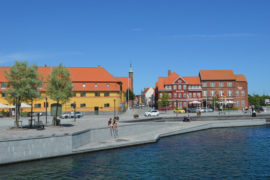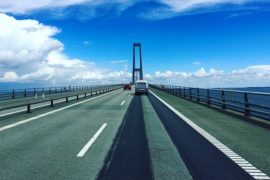Norway has its fjords and mountains, Sweden its forests and Finland its thousands of lakes. And the thing that makes Denmark stand out from its Nordic neighbours is the fact that it spreads across a large number of islands. Bridge geek? You’re gonna love Denmark.

Historically, these islands were accessible only by boats and ferries, but since the mid-1930s, a series of large bridges has begun to stitch Denmark’s patchwork of major islands together.
Over time these incredible feats of engineering have replaced the former ferries as Denmark’s transport icons, making it much easier to travel across the country by road or railway.
They are now such a big part of the country’s cultural history that several are even featured on Danish banknotes. So, here is our guide to the major bridges (and tunnels) connecting Denmark’s main islands.
Øresundsbron / The Øresund Bridge
Although technically more Swedish than Danish, since the longest stretch crosses Swedish waters, the iconic Øresundsbron links Denmark with Sweden. Even its official name is a merger of the two neighbours, combining the Danish ‘Ø’ and the Swedish word for bridge, bron.

Opened in July 2000, the Øresundsbron is probably Denmark’s best-known bridge, its fame having spread worldwide due to its leading role in the Scandi-noir crime series ‘The Bridge’.
At first sight, it looks like “half” a bridge, as it disappears into the ocean en-route with the final section reaching Danish shores via an underwater tunnel.
Europe’s longest combined road and rail bridge, this beautifully curved bridge and tunnel stretches for almost 16km in total.
It cost around 30 billion DKK to build (including the land connections), an amount estimated to be paid back by 2035 from the toll fees of the 7.5 million vehicles that take this journey annually.
Toll: 385 DKK (one way, regular car). There’s more info on crossing from Copenhagen to Malmö in this guide.
Storebæltsforbindelsen / The Great Belt Fixed Link
Gone are the days when more than half of Denmark’s population relied on ferries to reach the country’s capital. After ten years of construction, the Great Belt Fixed Link opened for traffic in 1998, and suddenly you could cross the Great Belt Strait between Funen and Zealand in just minutes.
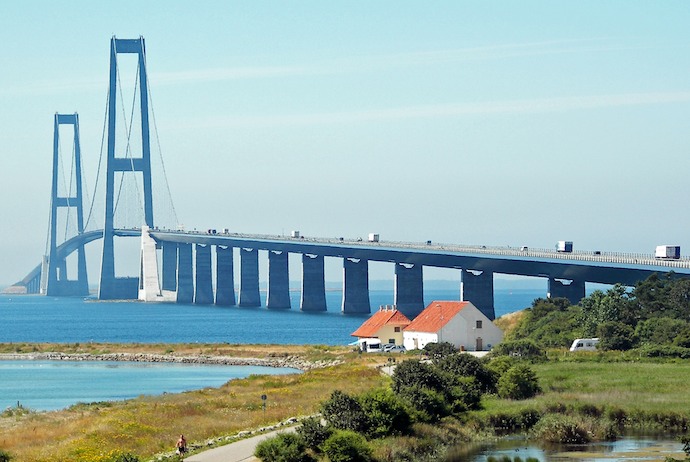
The Great Belt Fixed Link features a tunnel and two different bridges – the low eastern bridge and the higher suspension bridge to the west. In between, they connect seamlessly on the island of Sprogø, whose landmass was expanded to four times its former size to host this link.
And it is here that the train from Funen disappears into an underwater tunnel while cars climb the steeper suspension bridge. This is the most spectacular part of the journey due to the bridge’s 254-metre tall pylons, Denmark’s highest structures.
The entire link stretches almost 18km, and the 1664 metres between the pylons make it the fifth longest free-spanning bridge in the world, easily beating San Francisco’s famous Golden Gate.
The toll was originally planned to last just a decade, but is still in place, causing much debate amongst regular users.
Toll: 245 DKK (one way, regular car), but discounts apply on certain days and at specific times.
Den Gamle Lillebæltsbro / The Old Little Belt Bridge
It was a big deal when Jutland and the island of Funen were first connected by a bridge back in 1935. Until then, Funen had been a “free-floating” island linked to the mainland only by ferry.

The first bridge across the Little Belt Strait was originally designed to be rail-only, but as car use began to increase rapidly the plans were changed to include a road too.
Today, it supports the main railway line across Denmark, though most of the road traffic was diverted to a newer bridge across the strait in 1970.
When construction ended in 1935, the leftover material from the bridge was used to erect the 177-metre-high Odins Observation Tower in Odense. At the time, it was the world’s second highest tower, beaten only by the Eiffel Tower.
Fast forward to 2015, and the bridge became the first in Europe to offer bridge-walking across its structure. This has made it one of the region’s major tourist attractions, along with the nearby protected marine park of Lillebælt that is home a large population of porpoises.
Den Nye Lillebæltsbro / The New Little Belt Bridge
Built to ease the load on the Old Little Belt Bridge, this suspension bridge has spanned the strait between Funen and Jutland since 1970. This bridge was built in about half the time of the old one, and almost 50 years later it’s still a major thoroughfare for travellers and commuters across Denmark.
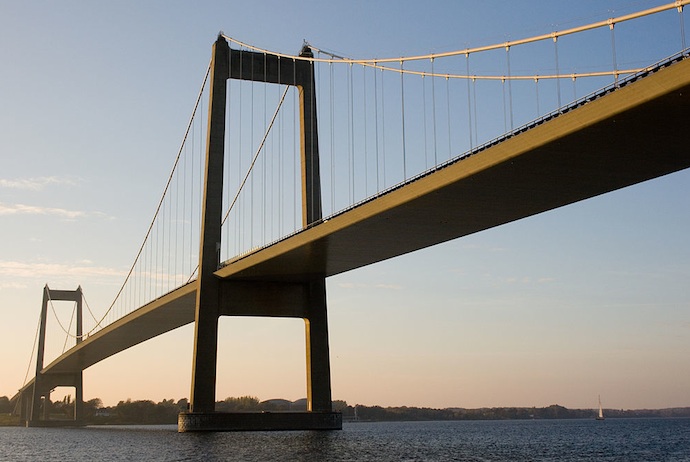
Like its cousin, it links the Fredericia region of Jutland with Middelfart on Western Funen. It’s also home to Denmark’s biggest one-day music festival, the appropriately named Rock Under Broen (Rock under the Bridge), which is held annually beneath the bridge.
Storstrømsbroen / The Storstrøms Bridge
When this iconic arch bridge was opened to traffic by Danish King Christian X in 1937, it was the first to connect Zealand with the large island of Falster, via the small island of Masnedø. Spanning the strait of Storstrømmen, it has been a major traffic artery for road and rail traffic ever since.
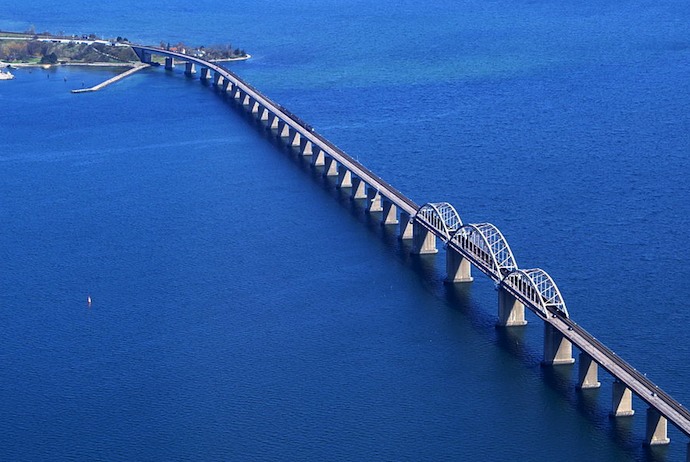
Sadly, its glory days will soon be over, as it’s outdated and has limited capacity. Plans for a replacement are already underway and a new bridge will take its place within a few years. So, you don’t have long to take this journey across a piece of Danish history before it disappears for good.
Farøbroerne / The Farø Bridges
Since 1985, the traffic over Storstrømsbroen has been shared by the nearby Farø Bridges, which connect Zealand with Falster across the island of Farø. Despite its limited size, the island of Farø is a major traffic hub leading onwards to the larger islands of Bogø and Møn via dams.
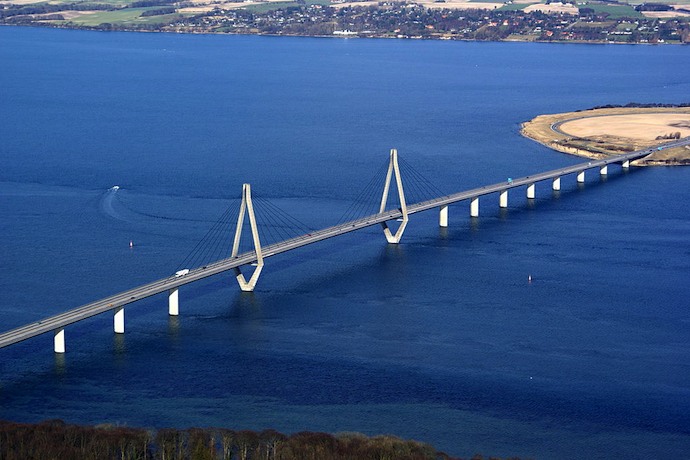
The low northern beam bridge to Farø and the higher southern cable-stayed bridge between Farø and Falster span 1526 and 1726 metres respectively. Marked by two distinctive diamond-shaped pylons, the south bridge is the more spectacular.
Dronning Alexandrines Bro / Queen Alexandrine’s Bridge
Named after the queen who opened it in 1943, this beautiful arched bridge connects Zealand to the island of Møn, known for the 6km-long stretch of dramatic, white, chalk cliffs at Møns Klint.
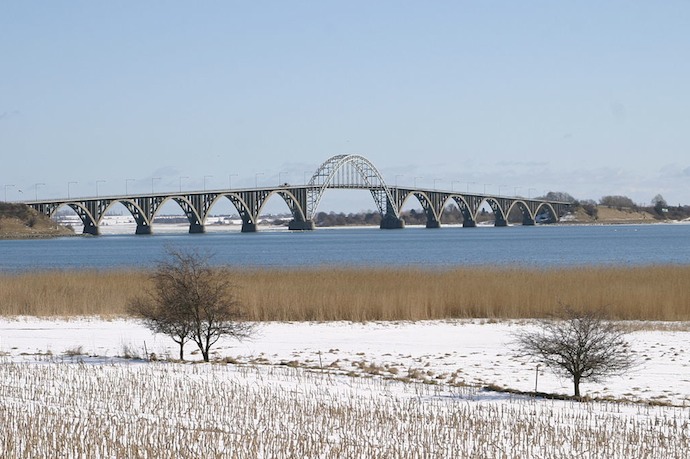
Also known as Mønsbroen or Ulvsundbroen, the bridge stretches for 745 metres across Ulvsund with ten smaller arches supporting the road and one larger central arch allowing ships to pass. These arches make it one of the most attractive bridges in Denmark.
Denmark’s other important bridges
As well as these iconic bridges, Denmark has several other major bridges that provide vitally important transport links across the country’s waterways.
These include the Svendborgsund Bridge connecting Funen with the Island of Tåsinge (and onwards to Langeland); the Vejle Fjord Bridge crossing the fjord of Vejle; the Sallingsund Bridge, which connects mainland Jutland to the island of Mors; and the Alssund Bridge linking Southern Jutland to the island of Als.
See also:
Getting from Copenhagen to Malmo

